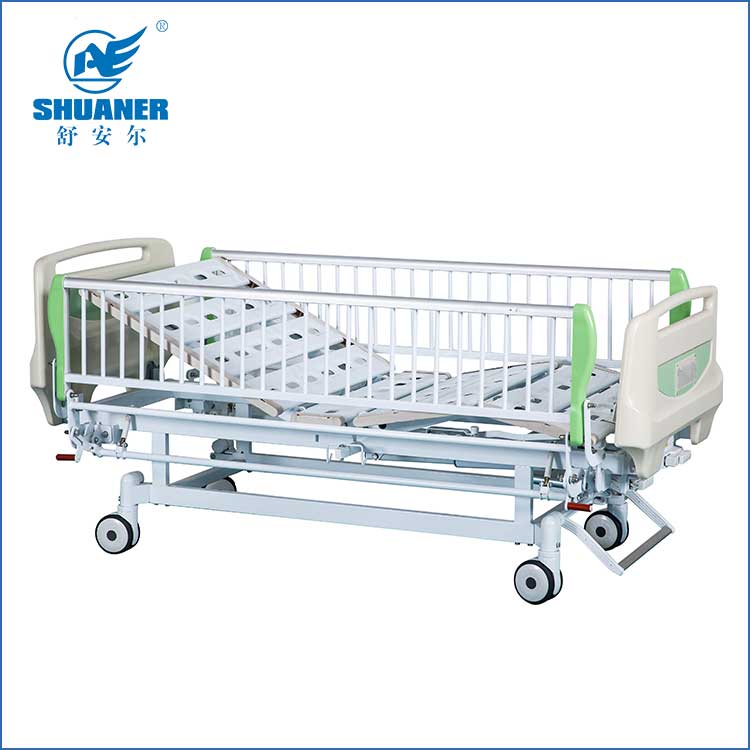- English
- Español
- Português
- русский
- Français
- 日本語
- Deutsch
- tiếng Việt
- Italiano
- Nederlands
- ภาษาไทย
- Polski
- 한국어
- Svenska
- magyar
- Malay
- বাংলা ভাষার
- Dansk
- Suomi
- हिन्दी
- Pilipino
- Türkçe
- Gaeilge
- العربية
- Indonesia
- Norsk
- تمل
- český
- ελληνικά
- український
- Javanese
- فارسی
- தமிழ்
- తెలుగు
- नेपाली
- Burmese
- български
- ລາວ
- Latine
- Қазақша
- Euskal
- Azərbaycan
- Slovenský jazyk
- Македонски
- Lietuvos
- Eesti Keel
- Română
- Slovenski
- मराठी
- Srpski језик
Features of child care beds
2023-08-08
Child care beds are medical equipment specially designed for children, with the following characteristics:
Safety: Children's care beds focus on the safety of children. It is usually designed with anti-collision to prevent children from bumping or falling on the side of the bed. Side rails and guard rails provide extra protection to prevent children from accidentally sliding out of the bed.
Humanized design: Child care beds are designed with the special needs and comfort of children in mind. It is usually equipped with an adjustable bed height to accommodate children of different ages. The bed board is soft, comfortable and breathable to ensure the comfort of children in bed.
Height Adjustability: Due to children's different heights and growth rates, child care beds often have adjustable bed board heights to accommodate children of different ages. This makes it easier for healthcare workers to access and care for children.
Convenience: Children's care beds are usually equipped with various conveniences, such as child-specific suspension racks, bedpans, drug storage cabinets, etc., to facilitate the nursing work of medical staff. The bed can also be equipped with wheels for easy movement and changing positions.
Companionship: In order to provide a better companionship experience, some child care beds are also designed with a companionable mode, allowing parents to accompany their children by the bedside. This helps reduce restlessness and anxiety in children while in the hospital.
Safety control: Children's care beds are usually equipped with safety control systems, such as bedside safety buttons or remote controls, through which medical staff can adjust the height and pitch angle of the bed to ensure the safety and comfort of children.
Safety: Children's care beds focus on the safety of children. It is usually designed with anti-collision to prevent children from bumping or falling on the side of the bed. Side rails and guard rails provide extra protection to prevent children from accidentally sliding out of the bed.
Humanized design: Child care beds are designed with the special needs and comfort of children in mind. It is usually equipped with an adjustable bed height to accommodate children of different ages. The bed board is soft, comfortable and breathable to ensure the comfort of children in bed.
Height Adjustability: Due to children's different heights and growth rates, child care beds often have adjustable bed board heights to accommodate children of different ages. This makes it easier for healthcare workers to access and care for children.
Convenience: Children's care beds are usually equipped with various conveniences, such as child-specific suspension racks, bedpans, drug storage cabinets, etc., to facilitate the nursing work of medical staff. The bed can also be equipped with wheels for easy movement and changing positions.
Companionship: In order to provide a better companionship experience, some child care beds are also designed with a companionable mode, allowing parents to accompany their children by the bedside. This helps reduce restlessness and anxiety in children while in the hospital.
Safety control: Children's care beds are usually equipped with safety control systems, such as bedside safety buttons or remote controls, through which medical staff can adjust the height and pitch angle of the bed to ensure the safety and comfort of children.
It is important to note that specific features of child care beds may vary by manufacturer and model. Before choosing to use, medical staff are advised to evaluate and choose according to their own needs and the actual situation of children.




